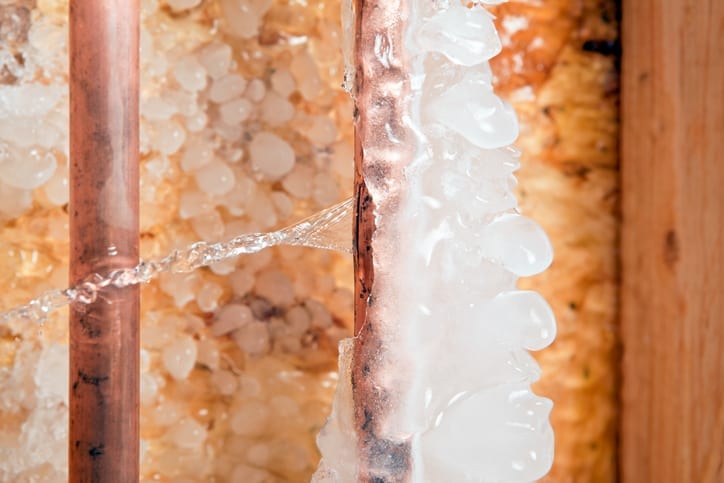
Are Your Pipes Protected?
Pipe insulation might not be top of mind for homeowners, yet it holds significant importance often overlooked by both homeowners and builders alike. Unfortunately, some contractors, aiming for a more appealing cost, might compromise on pipe insulation. Despite its underrated status, proper pipe insulation stands as a critical element in your home’s infrastructure. Beyond enhancing plumbing performance and lifespan, insulation acts as a safeguard, shielding pipes from potential damage caused by extreme temperatures and adverse weather conditions.
If you feel that your home’s plumbing system is not properly insulated, you should consult a plumbing professional immediately. Here are some important things you should know about pipe insulation:
Frozen Pipes
Inadequately insulated pipes face their most severe threat during freezing temperatures. When temperatures plummet, stagnant water within pipes can freeze and undergo expansion, leading to the formation of tiny cracks that may eventually rupture or burst. Proper insulation becomes crucial for exposed pipes, particularly in regions susceptible to below-zero temperatures. The minimal expense of additional insulation pales in comparison to the potential costs associated with repairing damages resulting from a burst pipe.
Outdoor pipes should be insulated, but even exposed pipes in your home can freeze if the temperature gets low enough. Be sure to look over pipes in the basement, attic, crawl spaces, under sinks, in utility rooms or garages, and the laundry room and insulate them. If you lose power during a winter storm or go on vacation during a cold snap, you could be forced to deal with the consequences of frozen or burst pipes.
Energy Costs
Believe it or not, insulating pipes can significantly impact your overall energy consumption. As utility costs rise and amid growing concerns about the environment, homeowners all over the country are paying more attention to how they use energy. Proper insulation around pipes limits heat transfer and provides a vapor barrier against moisture, which improves the thermal efficiency of your home and saves you money.
Water Damage
Poorly insulated pipes allow water to condense, which leaves pipes susceptible to standing water that can freeze in cold weather. This can cost you thousands of dollars in water damage to walls, ceilings, floors, and furniture. Condensation can also speed the deterioration of pipes, causing erosion, leaks, cracks, and gaps. By adding a bit of extra insulation, you can eliminate the potential for water damage from burst pipes and erosion.
Insulation Materials
The biggest problem with pipe insulation is keeping it dry. Traditional pipe insulation includes materials like fiberglass and minerals; these have been joined by flexible and rigid closed-cell glass products. Glass insulation provides a better barrier against moisture, helping pipes stay dry. Some contractors also use a wicking material that wraps around pipes to help absorb moisture and carry it away from the insulation jacket, where it evaporates. For underground pipes, most new insulation is made from polyurethane foam, which offers excellent protection and limits moisture accumulation.
Prevent Frozen Pipes
As temperatures drop during winter, the risk of frozen pipes increases. Taking proactive steps to prevent freezing can save you from potential plumbing headaches. Here are some practical tips to safeguard your pipes:
Drip Your Faucets:
Allow a small, steady drip from both hot and cold water faucets during extremely cold nights. This keeps water moving, reducing the risk of freezing.
Open Cabinet Doors:
Open cabinet doors under sinks to allow warm air to circulate around pipes. This is particularly important for pipes located against exterior walls.
Seal Drafts:
Identify and seal any drafts in your home. Cold air entering through gaps or cracks can make pipes more susceptible to freezing.
Insulate Exposed Pipes:
Insulate pipes in unheated areas like basements, crawl spaces, and attics. Use pipe insulation sleeves or wrap towels around exposed pipes to provide an extra layer of protection.
Disconnect and Drain Outdoor Hoses:
Disconnect garden hoses and drain water from outdoor faucets. Leaving hoses attached can cause water to back up into the pipes, increasing the risk of freezing.
Keep Thermostat Consistent:
Maintain a consistent temperature inside your home, even when you’re away. Avoid drastic temperature changes, as this helps keep your pipes from reaching freezing temperatures.
Apply Heat Tape:
Consider using heat tape on vulnerable pipes. This electrical heating element can be applied directly to pipes to provide warmth and prevent freezing.
Identify Cold Spots:
Identify areas in your home that tend to be colder, and pay extra attention to insulating pipes in those locations.
Emergency Preparedness:
In case of severe cold weather, know the location of your main water shut-off valve. If pipes do freeze, shutting off the water supply can minimize potential damage.
Taking these preventive measures can significantly reduce the risk of frozen pipes and the associated problems that come with them. Remember that a little preparation goes a long way in ensuring your plumbing stays functional during winter. If you have concerns or need assistance, don’t hesitate to consult with a plumbing professional.


